Every year, millions of patients visit their dermatologist’s office complaining of fine wrinkles and extra skin. Traditional treatments have included non-ablative lasers, laser resurfacing, topical retinoids (Retin-A) or the more invasive face-lift. Recently, a new non-ablative therapy has been developed called radiofrequency resurfacing - Thermage.
What is Thermage?
Thermage is a relatively new, non-invasive way to treat photoaging and wrinkles. Thermage employs radiofrequency energy that tightens skin and smoothes out wrinkles. Advantages are that it is an incision-free procedure which is fast and typically requires no downtime from normal activities. Unlike lasers, Thermage can be performed on patients of all skin types. The Thermage probe has two features: the radiofrequency generator and a cooling component that protects the outer layer (epidermis) of the skin. The radiofrequency energy heats the collagen deep in the skin, leading to an immediate firming of the skin. Over time, collagen synthesis is stimulated, leading to a more youthful look.
How Thermage Works
Thermage works by delivering heat energy through a handpiece to the deeper parts of the skin (dermis). This handpiece also has a cooling spray that protects the superficial part of the skin (epidermis) from injury. The heat energy causes the deeper tissues to contract to decrease the appearance of lines. Eventually new collagen develops and remodels to give an even firmer appearance to the skin. This technique is non-ablative in that it does not cause damage to the surface of the skin.
As discussed above, Thermage does not cause damage to the skin surface, unlike dermabrasion and laser resurfacing. Therefore, there is very little down time. Treatments can take up to two hours, depending upon the size of the treatment area. Patients can return to work the same day, unlike a facelift in which patients usually take at least 2 weeks to recover. Similarly, there is no scar unlike the surgical facelift procedure. Effects of the Thermage procedure can last from 6 months up to 2 years.
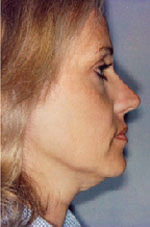 |
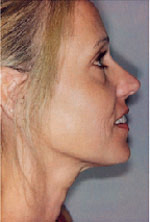 |
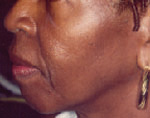 |
 |
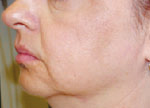 |
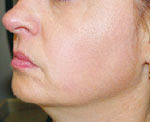 |
What does Thermage feel like?
Thermage is painful and requires an anesthetic cream and occasionally nerve blocks or IV sedation. Side effects can include redness, swelling, bumps and blisters. These should resolve over a few weeks.
During the procedure, you will experience a series of brief, deep heating sensations as the radiofrequency energy is delivered to your skin. The heating is required for your collagen to reach effective temperatures for tightening. The amount of energy delivered is controlled by the physician and is a balance between comfort and maximum results. While the deep layers are being heated, there is a cooling device that protects the outer layer of the skin for maximum comfort. Prior to treatment, an anesthetic lotion may be applied to enhance your comfort. Pain medication may also be prescribed prior to the treatment.
How long does the Thermage treatment take?
Depending on the size of the treatment area, Thermage can take anywhere from a few minutes to an hour. There may be additional time required to prepare your skin prior to the procedure.
What will my skin feel like after the Thermage treatment?
After Thermage treatment, you may notice immediate improvement in the texture of your skin; it may feel tighter, smoother and more youthful. Over the next weeks to months, you will notice additional improvement.
How many Thermage treatments will I need?
Often, a single Thermage treatment produces the desired effect. However, you and your physician will determine the course of treatment that is right for you.
How long do the results last?
Measurable firming of the skin appears gradually over 2 to 6 months after a single treatment session. However, many patients report tightening of the skin earlier. Results may last up to two years although long term studies are still in progress.
What are the risks of Thermage?
Side effects are rare (less than 1%) and include swelling, redness, bumps and blisters on or around the treated area. These side effects usually disappear in a few days or weeks. Even more rare but longer lasting is a side effect that leads to a depression in the skin. The risks and benefits of Thermage need to be discussed in detail with your physician.
How long before I can return to my normal activities?
You should be able to return to regular activities immediately. Some people experience some redness, but it usually disappears quickly.
How much does Thermage cost?
Thermage can cost from $900 - $4000, depending on area and degree of work. The old (original) protocol of one or possibly two treatments was very painful. Newer protocols entail more treatments over time with less discomfort. These newer protocols produce more desired effects and require less power per treatment.
Photos Courtesy of Julio Barba, M.D.,Kim Schuchardt, P.A. (Richard Neils, M.D.), Mark Nestor, M.D. and Robert Weiss, M.D.


